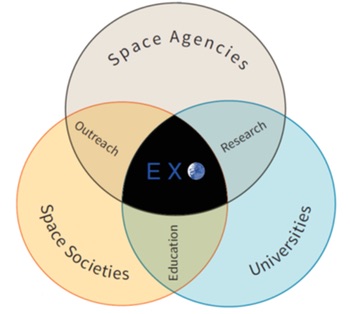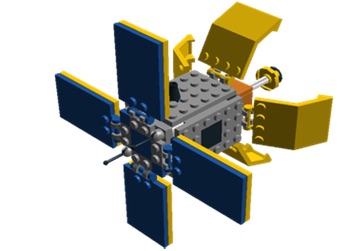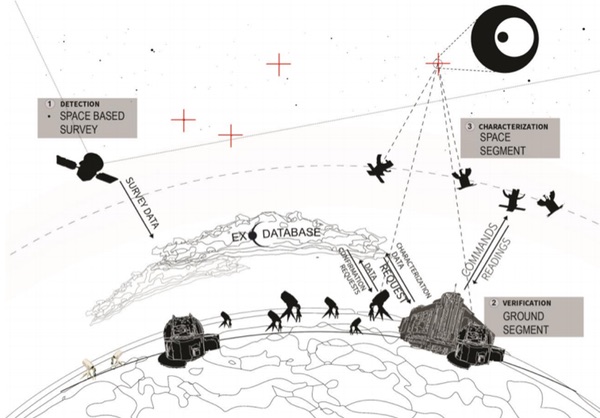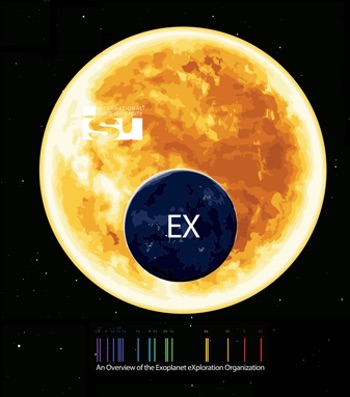Enhancing the field of exoplanetary researchby Thomas Godard and Daniel Long
|
| The most apparent need by the exoplanet community is a forum for cooperation and collaboration internationally and between disciplines. |
To give some perspective, since the first detections of exoplanets in the 1990s, the number of confirmed exoplanets has grown to approximately 1,800, with another 3,300 candidates awaiting verification as of October 2014. As both ground- and space-based observational and analytical tools improve, an increasing number of exoplanets are being discovered. These technological advancements have driven the discovery rate of planets, as well as increased understanding of their structural and atmospheric characterization. A better comprehension of the evolution and composition of exoplanets is essential to determine the probability of habitable worlds and how often life develops on them.
This analysis is the result of a project authored by a team comprised of individuals from 12 nations who attended the International Space University’s Space Studies Program hosted in Montreal during the summer of 2014 with help from experts who kindly provided their insight.
Exoplanetary adventures: the current state of the field
The project began by collecting information about the history and current state of exoplanetary research. This was accomplished by reviewing published roadmaps and speaking with experts from different disciplines and nationalities.
The most apparent need by the exoplanet community is a forum for cooperation and collaboration internationally and between disciplines. All six of the general recommendations from ESA’s “A European Roadmap for Exoplanets” from 2010 involve enhancing communication or collaboration. The NASA 2010 decadal survey, “New Worlds, New Horizons in Astronomy and Astrophysics,” also noted the importance of collaboration: “Complex and high-cost facilities… typically involve collaboration of multiple nations. These partnerships bring great opportunities for pooling resources and expertise to fulfill scientific goals that are beyond the reach of any single country.” That report also recommended, “Approximately every 5 years the international science community should come together in a forum to share scientific directions and strategic plans, and to look for opportunities for further collaboration and cooperation, especially on large projects.” These two documents highlight a need for increased international communication and collaboration.
There is also a need to engage different communities to increase the visibility of exoplanet research to a broader audience. Today, key organizations are primarily targeted at specific groups as professionals or academics. The effort to bridge the gap toward non-specialized audience and amateurs remains too small, although some initiatives have begun. One example is the Open Source differential photometry Code for Accelerating Amateur Research (OSCAAR) project, sponsored by NASA. This project allows amateur astronomers to submit their own data, gathered using amateur equipment, to help generate light curves for transiting exoplanets. Another example is Planethunters.org, which allows the general public to analyze data from NASA’s Kepler mission after a quick tutorial. These projects are still in development but are a promising way to engage amateur astronomers. However, more needs to be done to encourage the development of a truly interdisciplinary field, while also maintaining a strong outreach effort to leverage public fascination with exoplanets into increase public scientific literacy and to encourage students to pursue degrees in science, technology, engineering, and mathematics (STEM).
A look at NASA’s exoplanet exploration timeline and at ESA’s roadmap for exoplanets shows that, in the early 2020s, only the James Webb Space Telescope and the European mission PLATO (PLAnetary Transits and Oscillations of stars) will be operational, with WFIRST (Wide-Field Infrared Survey Telescope) foreseen for 2024. All these satellites are large-scale, expensive missions. In the current context of cost constraint, this type of flagship mission can jeopardize other potential missions due to lack of funding. In contrast, small satellite missions like Microvariability and Oscillation of Stars (MOST) and BRight Target Explorer (BRITE) have demonstrated the capability for smaller and less expensive satellites to perform valuable exoplanet science. In the near future, ExoplanetSat is another promising concept to provide significant scientific return for a fraction of traditional costs. These missions, and recent advances in miniaturization, demonstrate the feasibility of using small satellites to do big science and suggest that an opportunity exists to use smaller satellites to affordably advance exoplanet research on a tight budget.
| It is difficult for a single country to independently bear all of the costs associated with major exoplanet initiatives given limited budgets, technical capabilities, and workforces. In the current era, cooperation among countries and organizations may be the only way to achieve ambitious space goals. |
In addition to the missions that collect data, more work is needed to best analyze, provide access to, and store data. Numerous exoplanet databases exist, including the NASA Exoplanet Archive (Caltech, 2014), the Exoplanet Data Explorer (California Planet Survey, 2014), the Extrasolar Planets Encyclopedia (L’Observatoire de Paris, 2014), and the Open Exoplanet Catalogue (MIT, 2014). These databases often present exoplanet data inconsistently even when the data itself originates from the same source. Efforts to consolidate data, standardize data formatting, and standardize search methodologies would be beneficial for the exoplanet community.
With these insights, the team then switched focus to proposing actions that could help address the opportunities for improvement discussed above. The result was the development of an organization designed to facilitate the various communication, collaboration, and outreach efforts needed.
In addition, the team proposed the development of a low-cost microsatellite constellation with the objective of looking for biomarkers in the atmosphere of confirmed exoplanets. The satellite design would be sufficiently inexpensive to allow smaller nations or even universities to participate by building their own satellite, similar to the approach used by BRITE and QB50. These solutions are discussed in further detail below.
 The BRITE space telescopes are the size of a car battery. (credit: UTIAS Space Flight) |
Exoplanets eXploration Organization (EXO)
It is difficult for a single country to independently bear all of the costs associated with major exoplanet initiatives given limited budgets, technical capabilities, and workforces. In the current era, cooperation among countries and organizations may be the only way to achieve ambitious space goals. For these reasons, the team designed EXO to help address the perceived need for additional cooperation, collaboration, and outreach. This organization strives to achieve the following three objectives:
- Facilitate exoplanet research coordination and collaboration among the different exoplanet research stakeholders, including space agencies, academics of various disciplines, and amateurs;
- Leverage public interest in exoplanets to draw students into STEM fields and provide a source for international exoplanetary outreach; and
- Support and coordinate the development of a new exoplanetary research space mission expanding involvement to include smaller space agencies and universities.
To facilitate collaboration of exoplanetary research, EXO would provide forums for communication among space agencies, academics, amateurs, and the general public. This will take many forms, including planning international meetings dealing with all disciplines of exoplanetary science, identifying areas for cooperation and collaboration, working with existing database owners to develop the standardization of exoplanet data and metadata for easy access, and looking for opportunities for collaboration between different organizations.
The scientific objectives for the organization would be to provide additional analysis capability for the data provided by existing and future missions, such as the Kepler telescope and the Transiting Exoplanet Survey Satellite (TESS). Concretely, amateur scientists could participate in the data processing by verifying the planetary candidates, determining their size and mass, and performing spectroscopic analysis to determine their atmospheric composition.
 EXO would help to facilitate communication among different exoplanet stakeholders. |
Engaging schools internationally and expanding exoplanet outreach are good ways to create public support for supporting exoplanet missions and to draw students into STEM careers. Schoolteachers and educators would be provided lesson plans and access to experts. EXO would also engage directly with students in less traditional ways, like working with LEGO to create models of exoplanet-hunting satellites, or young student-oriented naming contests for select exoplanets to inspire fascination with the search for life beyond Earth. EXO would also engage in public outreach by establishing a social media presence, promoting attempts like PlanetHunters.org to engage the public, and highlighting discoveries that are unique or change our understanding of exoplanets.
UniQuE, the UNIted QUest for Exoplanets
The scientific mission objectives for the organization would be to design a cost-effective small satellite mission to provide characterization data that compliments the existing survey data. This will be achieved through the UniQuE (United Quest for Exoplanets) mission. UniQuE consists of a constellation of low-cost microsatellites that would characterize exoplanet atmospheres with an emphasis on finding biomarkers on confirmed transiting exoplanets.
 Proposed LEGO model of UniQuE |
Atmospheric analysis of the planet would be done by transit spectroscopy: measuring irradiance, primarily infrared, observed during the transit of an exoplanet in front of or behind its host star. The irradiance received is composed of light directly from the host star and the light emitted from the target exoplanet. During the transit, the irradiance varies, and it is this variation that UniQuE would analyze. With the aid of a highly sensitive spectrometer, it is possible to determine the chemical compounds in the exoplanet atmosphere. Key target molecules believed to be necessary to develop life as we understand it include molecular oxygen, water, carbon dioxide, and methane (Rothman, et al., 2009).
| The UniQuE mission is a cost effective and innovative way to advance exoplanet research involving the global community while operating within the constraints of modest budgets. |
With the UniQuE mission, EXO and its partner institutions would strive to include emerging spacefaring nations in exoplanet exploration. This concept of operations relies on existing space-based survey missions like TESS to detect new exoplanets (Stage 1 in the figure below). Exoplanet candidates would then be confirmed through follow-up observations (Stage 2).
 Concept of operation for the constellation of UniQuE microsatellites |
Among these confirmed exoplanets, those within the habitable zone of their host star with characteristics thought to be compatible with life would be selected for additional analysis. The constellation of UniQuE satellites would observe the exoplanets during an upcoming transit with the use of infrared spectrometers to determine their atmospheric composition (Stage 3). Adding satellites, or equipping satellites with different instruments, could increase the overall sensitivity and expand the observed spectral range of the constellation, allowing the detection of sufficient biomarkers to imply the existence of life.
Transits of potentially habitable planets are expected to occur with only modest frequency. This would allow operating entities to have free observation time between transit events. During this time, partners could use their UniQuE satellite for their own secondary mission objectives.
A standardized design based on a 12-unit CubeSat layout, weighing about 15 kilograms, was chosen as the baseline UniQuE microsatellite platform. EXO would provide an overall baseline design and participating entities will have the freedom to individually design and size all relevant subsystems so long as overall mission requirements are met, allowing the freedom for the inclusion of innovative concepts.
A call to action
Exoplanetary research is an exciting and young field of research that holds the potential to help answer the fundamental question, “Are we alone in the universe?” Effective international and interdisciplinary communication and collaboration are important to advance the field in a timely and cost effective way. Founding EXO is an excellent way to promote the sharing of ideas across borders and disciplines. The UniQuE mission is a cost effective and innovative way to advance exoplanet research involving the global community while operating within the constraints of modest budgets. The authors believe in the value of pursuing both of these goals and invite you learn more from the full report at http://tinyurl.com/o315759 and to share your thoughts or advice at ExoplanetExplorationOrg@gmail.com.
